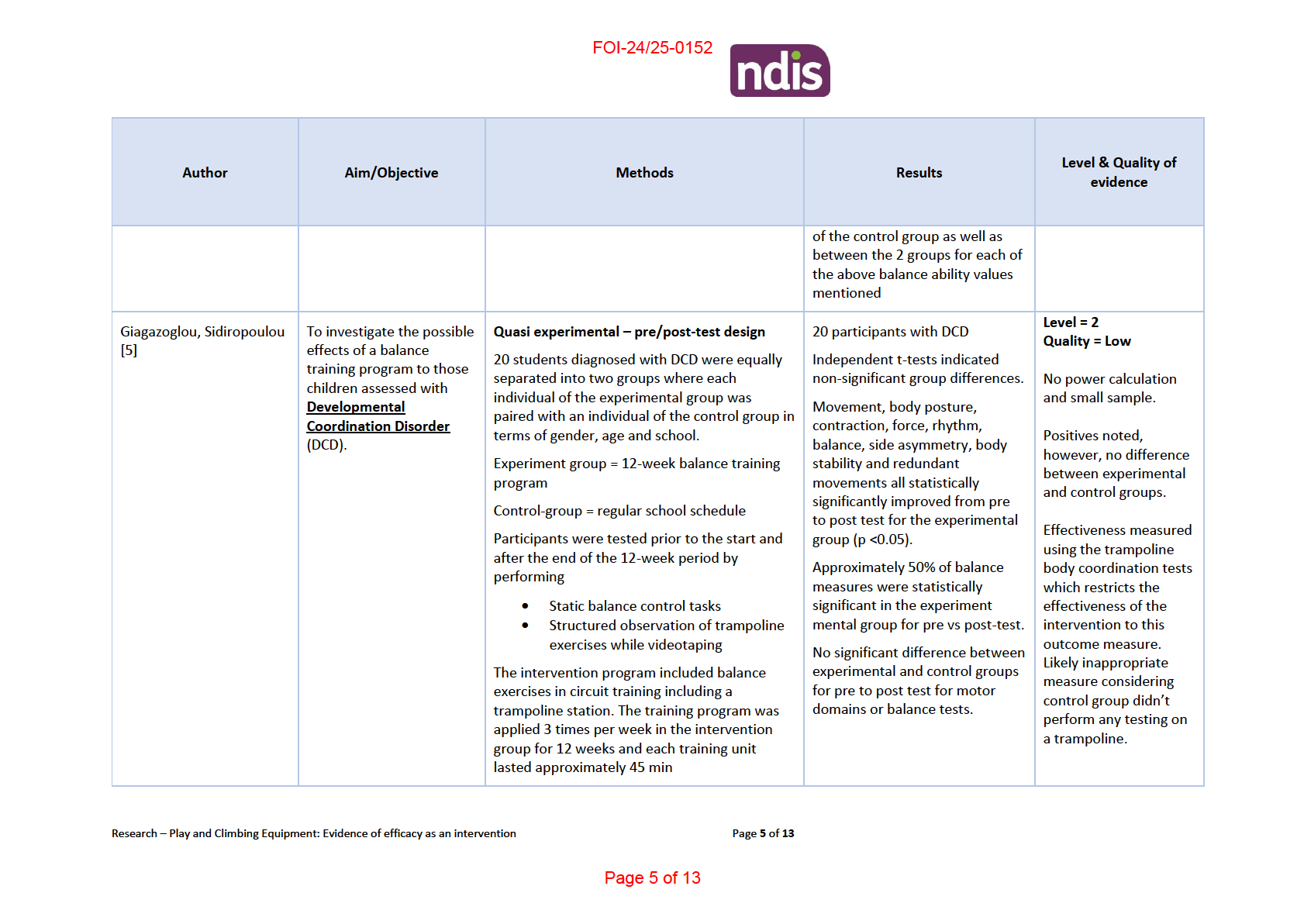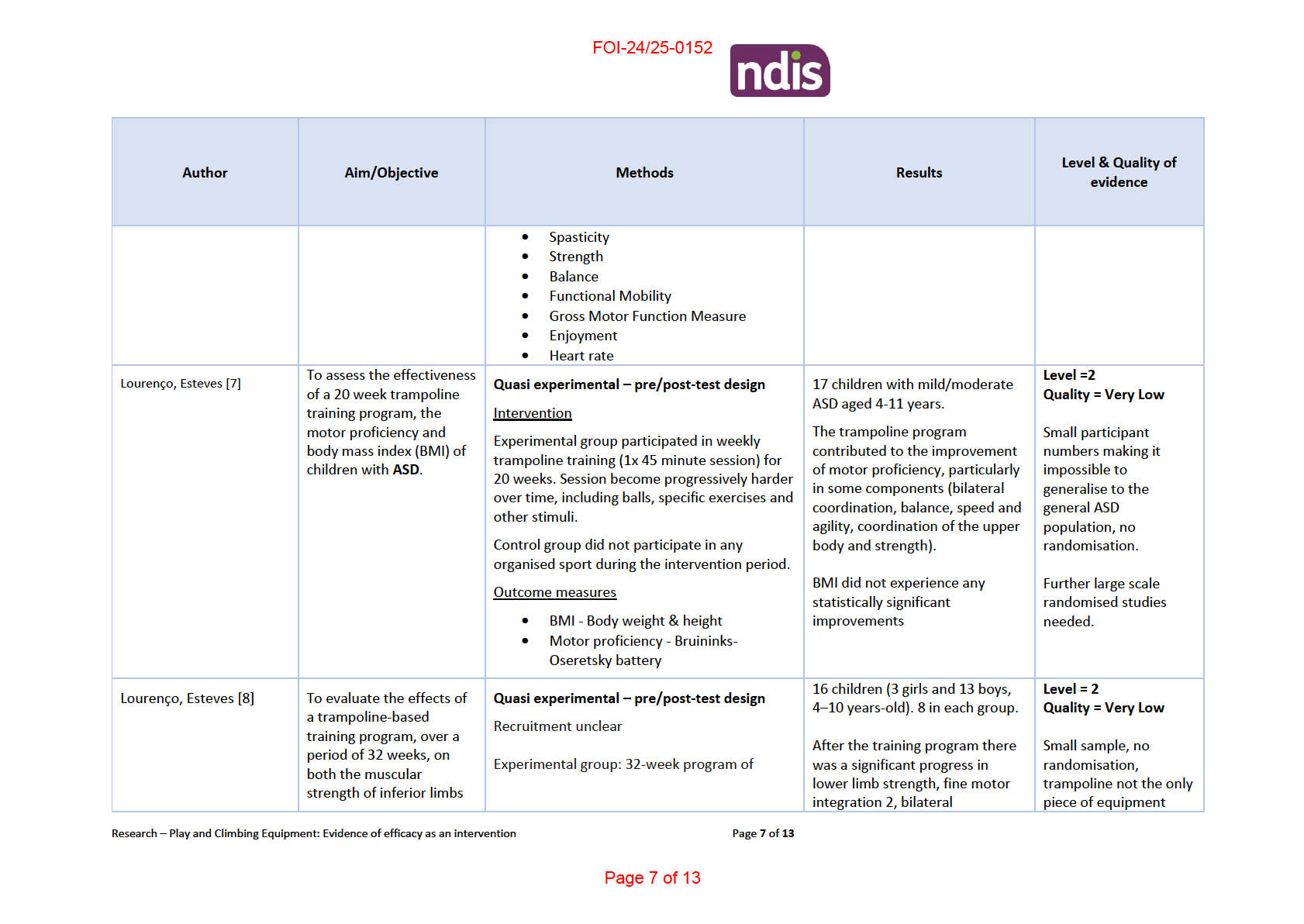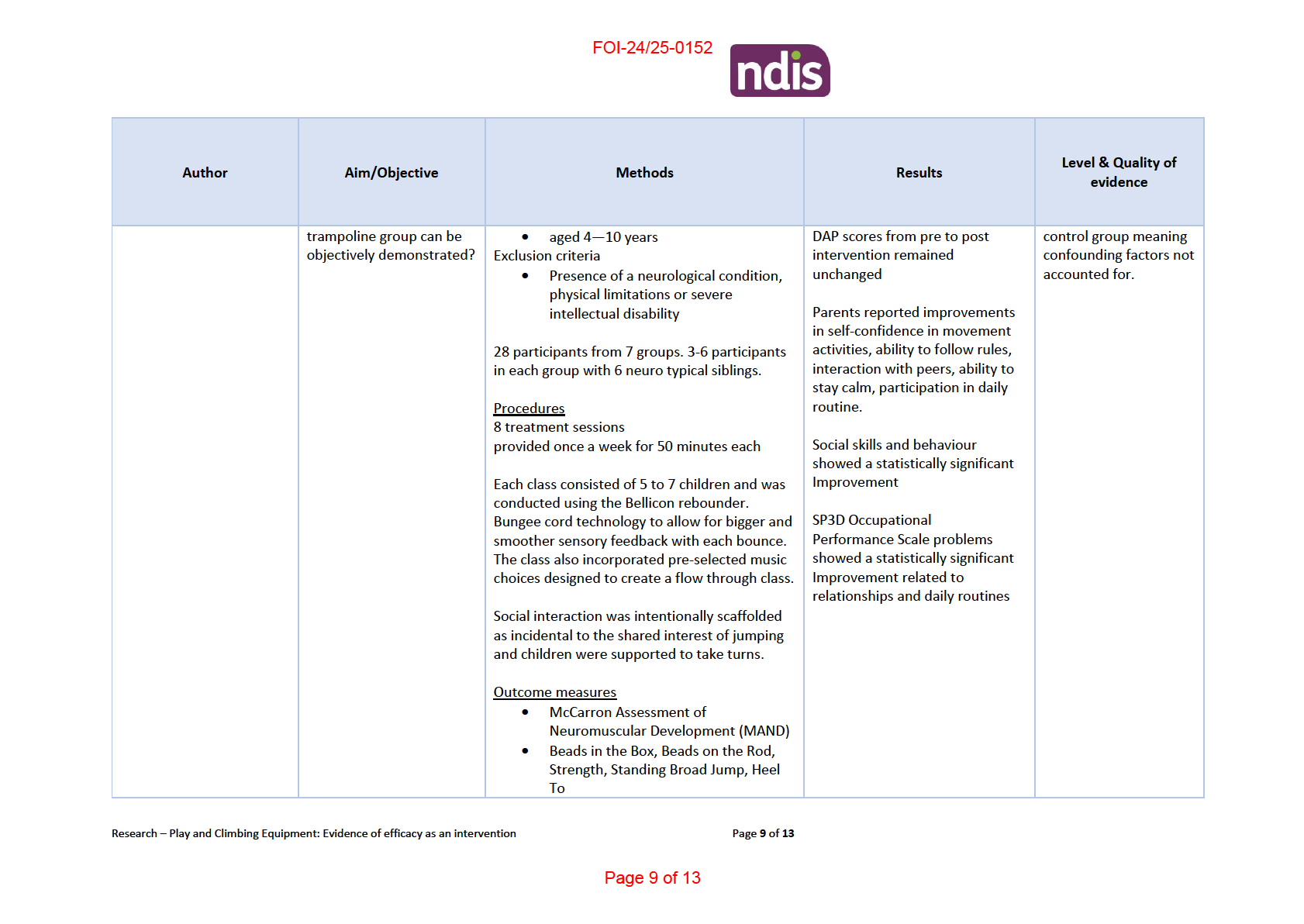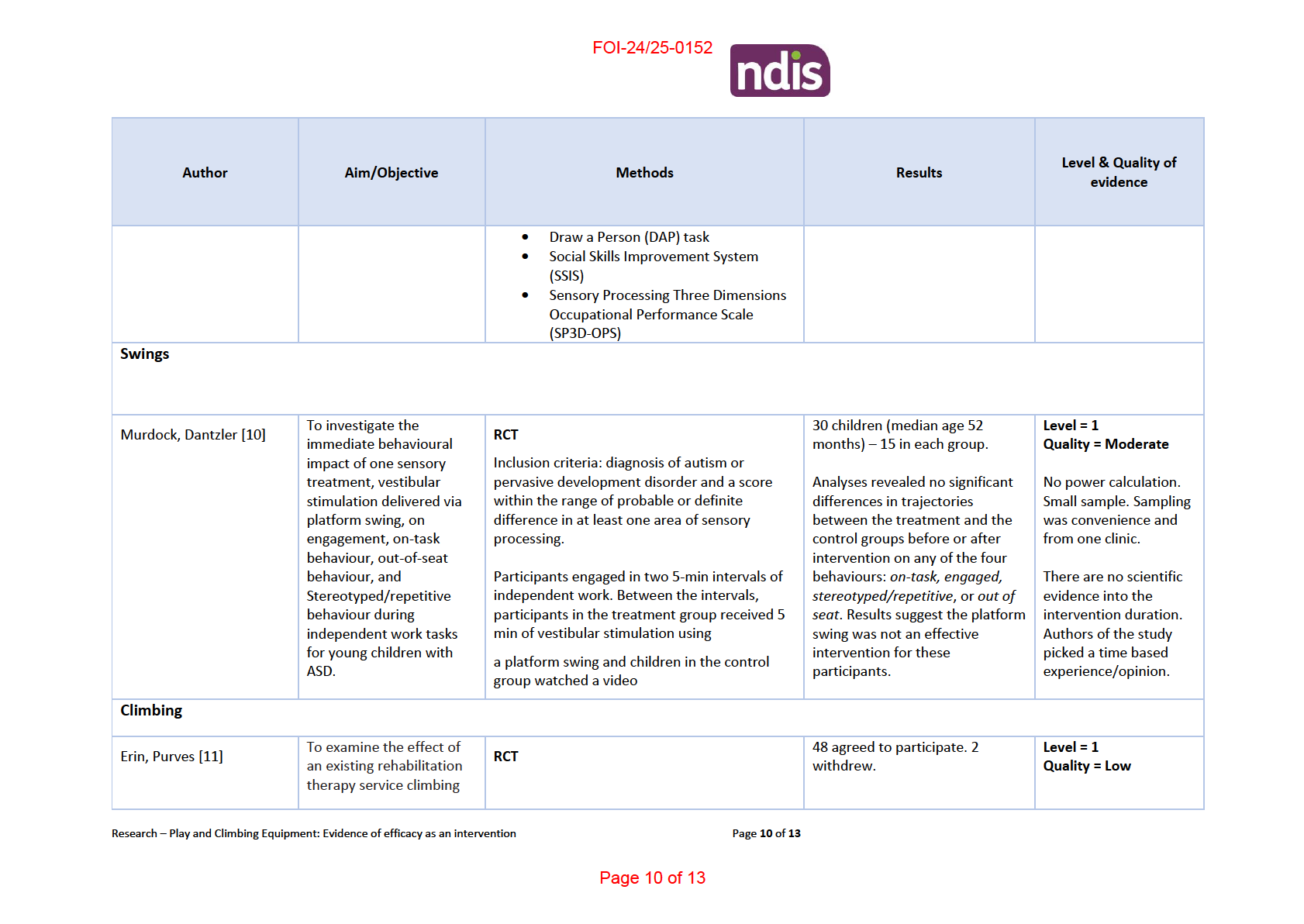 DOCUMENT 2
DOCUMENT 2
FOI-24/25-0152
Research – Play and Climbing Equipment: Evidence of efficacy as an
intervention
Is there any research based evidence which indicates that play/climbing
equipment/swing/trampoline is a recommended intervention?
• If so, for what conditions is it recommended?
Brief
• For which age ranges is it recommended?
• What are the intended functional outcomes of the recommended
intervention?
Is it a long term or short term recommended intervention?
Date
26/03/2021
Requester(s)
Naomi s47F - personal -
priv Senior Technical Advisor (TAB/AAT)
Researcher
Jane s47F - personal priv (Research Team Leader - TAB)
Cleared
N/A
Please note:
The research and literature reviews collated by our TAB Research Team are not to be shared external to the Branch. These
are for internal TAB use only and are intended to assist our advisors with their reasonable and necessary decision-making.
Delegates have access to a wide variety of comprehensive guidance material. If Delegates require further information on
access or planning matters they are to call the TAPS line for advice.
The Research Team are unable to ensure that the information listed below provides an accurate & up-to-date snapshot of
these matters.
1 Contents
2
Related TAB Research ..................................................................................................................... 2
3
Summary ......................................................................................................................................... 2
4
Literature Review ............................................................................................................................ 2
4.1
Trampolines ............................................................................................................................ 2
4.2
Climbing .................................................................................................................................. 3
4.3
Swings ..................................................................................................................................... 3
5
References .................................................................................................................................... 12
Research – Play and Climbing Equipment: Evidence of efficacy as an intervention
Page
1 of
13
Page 1 of 13

FOI-24/25-0152
2 Related TAB Research
• NED20/381652: RES AAT THER Climbing Therapy for Cerebral Palsy 2020/0122
• NED21/93314 RES THER Play and Climbing Equipment: types, standards, safety, lifespan,
price range, maintenance, statistics, public and commercial playgrounds 2021/176
3 Summary
• Literature in support of the provision of play/climbing equipment, swings or trampolines is
weak and therefore should not be recommended as an evidence based intervention.
• No studies could be located that investigate these interventions in the home setting
4 Literature Review
Sensory-Based Interventions (SBIs) are often recommended to enable function/participation in
children with ASD. Still, there are limited studies to evaluate their effectiveness. In a survey by Peña,
Ng [1], parent’s perceptions of the uptake and acceptability of SBI’s were examined. The use of the
trampoline (54.6%) was the most frequently therapist recommended SBI followed by massage and
oral-motor tools [1]. It is of concern that some SBI’s identified such as trampolines, oral motor tools,
weighted backpacks, weighted lap snake, wrist and ankle weights as well as compression vests are
being
recommended to parents to manage challenging behaviours without any controlled studies
examining the effectiveness of their use [1].
4.1
Trampolines
The majority of studies investigating trampolines look at the number of injuries sustained at home or
at trampoline play centres [2, 3]. There are a handful of studies investigating the use of trampolines
as an intervention for children with autism spectrum disorder, intellectual disability, cerebral palsy
and developmental coordination disorder. All studies delivered the intervention within a clinic
setting using various types of trampolines/adaptive bungee cords. Studies demonstrated mixed
results relating to motor ability, balance, leg strength and sensory processing. Larger randomised
studies demonstrated improvements following trampoline intervention, however, there were no
statistically significant differences between the intervention and the control groups who received no
intervention. No studies investigate whether the provision of a trampoline at home improves level of
Research – Play and Climbing Equipment: Evidence of efficacy as an intervention Page
2 of
13
Page 2 of 13

FOI-24/25-0152
functioning. The body of evidence around the use of trampolines is weak and should not be
recommended.
4.2
Climbing
A single randomised controlled trial on the effects of climbing for children with “special needs” was
located. The quality of the study was low and showed mixed results. Self-efficacy ratings improved
significantly, however, children’s judgments of their athletic and social competence and global self-
worth did not change. Not studies investigating at home climbing equipment could be located. The
body of evidence around the use of climbing equipment/rock climbing is weak and should not be
recommended.
NED20/381652: RES AAT THER Climbing Therapy for Cerebral Palsy 2020/0122 provides information
on the efficacy of wall/rock climbing in children with cerebral palsy (CP). In brief, there is not enough
high quality evidence to support the use of climbing therapy as an intervention for CP.
4.3
Swings
A single randomised controlled trial has investigated the use of a platform swing to reduce sensory
behaviours in children with ASD. Analyses revealed no significant differences in trajectories between
the treatment and the control groups before or after intervention on any of the four behaviours:
on-
task, engaged, stereotyped/repetitive, or
out of seat. Results suggest the platform swing was not an
effective intervention for these participants. No studies investigating swings in the home setting
could be located. The body of evidence around the use of swings is weak and should not be
recommended.
Research – Play and Climbing Equipment: Evidence of efficacy as an intervention Page
3 of
13
Page 3 of 13









FOI-24/25-0152
5 References
1.
Peña M, Ng Y, Ripat J, Anagnostou E. Brief Report: Parent Perspectives on Sensory-Based
Interventions for Children with Autism Spectrum Disorder. Journal of Autism and Developmental
Disorders [Internet]. 2020 2020/08/27. Available from: https://doi.org/10.1007/s10803-020-04644-
8.
2.
Muljadi JA, Chaijenkij K, Arirachakaran A, Kongtharvonskul J. Comparative surgical risk
between type of trampoline (size and place) and type of patients (age and sex) in trampoline related
injury: a systematic review and indirect meta-analysis. BMC Sports Science, Medicine and
Rehabilitation [Internet]. 2020 2020/07/06; 12(1):[37 p.]. Available from:
https://doi.org/10.1186/s13102-020-00185-w.
3.
Chen M, Cundy P, Antoniou G, Williams N. Children bouncing to the emergency department:
Changes in trampoline injury patterns. Journal of Paediatrics and Child Health [Internet]. 2019
2019/02/01; 55(2):[175-80 pp.]. Available from: https://doi.org/10.1111/jpc.14144.
4.
Giagazoglou P, Kokaridas D, Sidiropoulou M, Patsiaouras A, Karra C, Neofotistou K. Effects of
a trampoline exercise intervention on motor performance and balance ability of children with
intellectual disabilities. Research in Developmental Disabilities [Internet]. 2013 2013/09/01/;
34(9):[2701-7 pp.]. Available from:
https://www.sciencedirect.com/science/article/pii/S0891422213002266.
5.
Giagazoglou P, Sidiropoulou M, Mitsiou M, Arabatzi F, Kellis E. Can balance trampoline
training promote motor coordination and balance performance in children with developmental
coordination disorder? Research in Developmental Disabilities [Internet]. 2015 2015/01/01/; 36:[13-
9 pp.]. Available from: https://www.sciencedirect.com/science/article/pii/S0891422214004004.
6.
Germain AM, Blackmore AM, Gibson N, Newell B, Williams SA. Effects of Adaptive Bungee
Trampolining for Children With Cerebral Palsy: A Single-Subject Study. Pediatric Physical Therapy
[Internet]. 2019; 31(2). Available from:
https://journals.lww.com/pedpt/Fulltext/2019/04000/Effects of Adaptive Bungee Trampolining f
or.11.aspx.
7.
Lourenço C, Esteves D, Corredeira R, Seabra A. Children with autism spectrum disorder and
trampoline training. Wulfenia Journal [Internet]. 2015; 22(5):[342-51 pp.]. Available from:
https://d1wqtxts1xzle7.cloudfront.net/38613709/Lourenco et al. 2015 Children with autism spe
ctrum disorder and trampoline training Carla.pdf?1440938716=&response-content-
disposition=inline%3B+filename%3DChildren with autism spectrum disorder a.pdf&Expires=1616
628912&Signature=cmeqOdBJ-bXFoYbr6oCsCSAY7WfjbGbTj9FL2A-du5EYB2KMvG4qamW-Jp-
PCXsvRGJPU8Wz~eQzfRyc4GLJr3Mo65LRrpJZKsaYZFE6IwJzrqs9TtUhpRjKGrXIf3eZg7YlArWA3QtBZ23
FmpnE8qjhlDWJmXlOGmHgEzDc2vlMcWdG6oJJvM3ss~aCre2DB4PoTS-
xjwdL7YUKrrfZBb1E8Iv37N1mu4cVQfEknM-2yC3td42QYn9pHYugRBWyh-
Kd3S1yza4EuCupt5MhwAImklEk40WOeTDvrMOjJNBhMOUmSq4Oo2ItHqEs0Sqbw~z-
gdtdT8fBx1elHr9SoQ &Key-Pair-Id=APKAJLOHF5GGSLRBV4ZA.
8.
Lourenço C, Esteves D, Corredeira R, Seabra A. The effect of a trampoline-based training
program on the muscle strength of the inferior limbs and motor proficiency in children with autism
spectrum disorders. Journal of Physical Education and Sport [Internet]. 2015; 15(3):[592 p.].
Available from: https://efsupit.ro/images/stories/nr3.2015/ART%2089.pdf.
9.
Schoen S, Einck C, Spielmann V, Valdez A, Miller L. A Trampoline Group: Feasibility,
Implementation, and Outcomes. Autism and Developmental Disorders [Internet]. 2019; 17(2):[58-86
Research – Play and Climbing Equipment: Evidence of efficacy as an intervention Page
12 of
13
Page 12 of 13

FOI-24/25-0152
pp.]. Available from:
https://pdfs.semanticscholar.org/4329/fcbb86925165ba4a12e7cb86bc3386d6da05.pdf.
10.
Murdock LC, Dantzler JA, Walker AN, Wood LB. The Effect of a Platform Swing on the
Independent Work Behaviors of Children With Autism Spectrum Disorders. Focus on Autism and
Other Developmental Disabilities [Internet]. 2013 2014/03/01; 29(1):[50-61 pp.]. Available from:
https://doi.org/10.1177/1088357613509838.
11.
Erin RM, Purves PL, Julie S, Ryan ER, Viviene AT. Effect of Indoor Wall Climbing on Self-
Efficacy and Self-Perceptions of Children with Special Needs. Adapted Physical Activity Quarterly
[Internet]. 2009 01 Jul. 2009; 26(3):[259-73 pp.]. Available from:
http://journals.humankinetics.com/view/journals/apaq/26/3/article-p259.xml.
Research – Play and Climbing Equipment: Evidence of efficacy as an intervention Page
13 of
13
Page 13 of 13












